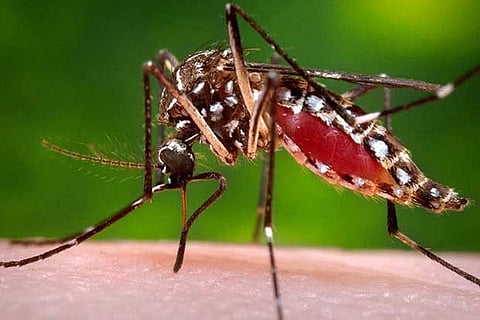

Chennai
For the first time, scientists have used the gene-editing tool Crispr-Cas9 to render humans effectively invisible in the eyes of Aedes aegypti mosquitoes, which use dark visual cues to hunt, according to a paper recently published in the journal Current Biology. By eliminating two of that mosquito’s light-sensing receptors, the researchers knocked out its ability to visually target hosts. “Nobody has studied this before,” said Neha Thakre, a post-doctoral researcher at the University of California, San Diego, who studies Crispr as a mosquito control tool. Dr. Thakre, who was not involved with the research, said she saw the study as a “great start” to understanding what controls mosquito vision. Aedes aegypti is a salt-and-pepper scourge on humans across the world. The females, in search of the blood they need to lay their eggs, infect tens of millions of people each year with flaviviruses that lead to dengue, yellow fever and Zika.
“The better we understand how they sense the human, the better we can control the mosquito in an eco-friendly manner,” said Yinpeng Zhan, a post-doctoral researcher at the University of California, Santa Barbara, and the lead author on the paper. Anopheles mosquitoes, which spread malaria, hunt at night, whereas Aedes aegypti hunts under the sun, at dawn and dusk. The species depends on a fleet of senses to find blood. A mere whiff of carbon dioxide, a sign that someone or something has just exhaled nearby, sends the mosquito into a frenzied flight. “They can also detect some of the organic cues from our skin,” such as heat, humidity and stench, said Craig Montell, a neurobiologist at the University of California, Santa Barbara, and an author on the study. But if there is no suitable host, the mosquito will fly straight to the closest-seeming target: a dark spot. In 1937, scientists observed that Aedes aegypti mosquitoes were specifically attracted to people with dark clothing. But the molecular mechanism by which mosquitoes visually sensed their targets was largely unknown.
The new paper could inform future strategies to control mosquito populations. If female mosquitoes were unable to see hosts, they would have a harder time finding the blood required for their eggs to develop. “The population would crash,” Dr. Montell said. The researchers have yet to expose the double mutants to hosts. If and when they do, Dr. Thakre is curious to know exactly how impaired vision affects the ability of mosquitoes to actually feed on blood, given the insects’ many other senses. “The thing you want to control is a mosquito bite,” Dr. Thakre said.
As climate change heats up regions of the planet, it lays out an unwelcome welcome mat for Aedes aegypti to enter new areas, including parts of China and America. “Every year there’s a pandemic from mosquito-borne diseases,” Dr. Montell said from his home in Santa Barbara. In California, Aedes aegypti was first spotted in 2011 in Los Angeles County and has now spread as far north as Sacramento. The mosquitoes will only continue to spread, their eggs glued to our suitcases and cars, awaiting the day when they hatch into adults and begin hunting, compound eyes wide open.
The writer is a journalist with NYT©2021
The New York Times
Visit news.dtnext.in to explore our interactive epaper!
Download the DT Next app for more exciting features!
Click here for iOS
Click here for Android